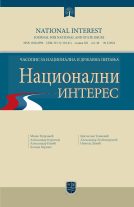- Home page
- Researchers
- Nenad R. Putnik
Nenad R. Putnik
Fakultet bezbednosti, Univerzitet u Beogradu.

I-DOSING – DIGITAL DRUG?
In 1839, Heinrich Wilhelm Dove discovered that two constant tones, emitted at slightly different frequencies at each ear, conjured the listener to register this as a fast rhythm, and this phenomenon was called binaural beats. Among the authors today, there are conflicting opinions about whether this phenomenon can be "abused". Binaural beats are brainwave entertainment technology, designed to put the brain into the same activity level as when meditating using traditional methods. Binaural beats affect mood, concentration and sleep by modifying brain waves based on the brain's response patterns to dichotomous and different frequencies. Therapy by music, as well as the use of certain specially arranged sounds to relieve anxiety, stress or health problems such as high blood pressure, are not unknown and are even widely accepted and used in different branches of medicine. However, when scientists, and companies in particular, point out that binaural beats, used in a certain way, can affect the state of consciousness and behaviour, referring to the feelings created by drug use, then it raises serious questions. Digital drugs or binaural beats that support the creation of a feeling similar to that of drug abuse, is a phenomenon about which less is known, Considering that, especially the young population, is already being treated today. Medical treatments have been created to get rid of addiction to the Internet, smartphones and similar technologies, it is clear that any innovation, like medicine, can also have the possibility of abuse. Bearing this in mind, binaural tones created and used to intentionally influence the mood and flow of thoughts (not part of medical treatment under professional supervision) can and must be viewed as a security threat in socio-pathological phenomena.

CONSTRUCTION STRATEGY NATIONAL IDENTITY OF MONTENEGRO
As one of the youngest countries in Europe, Montenegro is a particularly interesting example of how a symbolic competition between two nation-building projects takes place in the political context. The issue of Montenegrin national identity has been at the heart of Montenegrin politics since the late 19th century, but there has never been a clear consensus on who exactly Montenegrins are. Supported by the reconstructed meaning of the Montenegrin nation, the newly formed Montenegrin national consciousness accelerated after the break with Serbia and the declaration of independence on May 21, 2006. Since the break-up of Yugoslavia, Montenegro has gone through transitions from a republic in the Federal Republic of Yugoslavia (FRY) to a member state of Serbia and Montenegro in the period 2003-2006. year, and after that to an independent state from 2006 year. However, the transition of statehood was not the result of a broader popular consensus. The split in the ruling political party of reformed communists, the Democratic Party of Socialists (DPS) in 1997, sparked a political struggle between the party's two former factions. Over a period of 15 years, the changing political programs of the ruling DPS and the opposing Socialist People's Party (SNP) served as a source for redefining the meaning of ethnic (national) identity. In their competition for social, political or economic resources, Montenegrin elites, by applying political and ethno-cultural state policy and active use of the media, have managed to turn certain facts and events into reference points for the citizens of Montenegro by identifying themselves. Therefore, these events became the basis of belonging to a community and at the same time helped to separate the specific community of Montenegro from Srpska.
